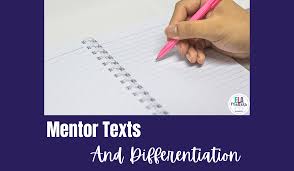To be a mentor text, the piece of writing needs to be one primary thing: good quality writing. Berry selects articles from esteemed journalists or short extracts from novelists who have a particularly unique style. Students are encouraged to find pieces that they believe are good, even if they aren’t sure what “good” means. All of the texts are examples of good writing which students can replicate in their own pieces. For students who need extra challenge, select a text which is going to offer the sophistication and dynamics you want to see in their writing. For those who may be weaker, given them an achievable texts which they can model their own writing off of.
Working with mentor texts in the classroom can be approached in many different ways, but the same thread should be approached with all mentor text in order to teach students to recognize quality writing.
1. Read the text
This sounds obvious, but how often do students look anywhere but at the page? If mentor texts are short, they should hold the attention of a student longer than a book or a short story will. Berry gives every student a copy of the mentor text and then reads it aloud to them. Reading it aloud has benefited the students in two ways: they hear fluency being modeled and the content is almost always guaranteed to get to the student. For weaker readers, this is an excellent way to walk them through how to read with pace and flow.
2. Identify what makes it “good?”
Monosyllables? Use of repetition? Awesome comma usage? A simile? Identifying literary devices in the wild makes reading like a scavenger hunt. You could provide the students with a list of what they should find or you can let it be organic and let them identify what they think is important. Berry and her students always try to find a handful of techniques in each piece: some pieces are chosen purposefully to teach a skill, while others are student selected due to content and interest. Differentiation is natural here – focus on the students in front of you and tailor the text and skills to their needs. This can be done is small groups, one to one, or by class.
3. Practice it
If you use a book such as Linda Reif’s The Quickwrite Handbook, you already have a number of mentor texts selected for you with writing prompts students can engage in following reading the text. In this way, mentor texts could serve as a beautiful transition into narrative writing. If students respond creatively to a series of mentor texts, they may have the start of a creative piece waiting to be developed.
4. Build upon it
Once these techniques have been identified and practiced, students can become accountable for them. This is particularly useful if you are trying to see grammar improve and want to practice sentence types with students. Create a class list of good writing techniques as seen in mentor text and posted in your classroom. Outline success criteria prior to writing a creative piece and reference the skills covered during mentor text work. Hold your students accountable for these techniques in their writing and remind them to write with mentor text close to hand.
If students become better writers by becoming better readers, let’s expose them to good writing in short bursts. In theory, this is a fantastic idea, so let mentor texts help you do the teaching!

